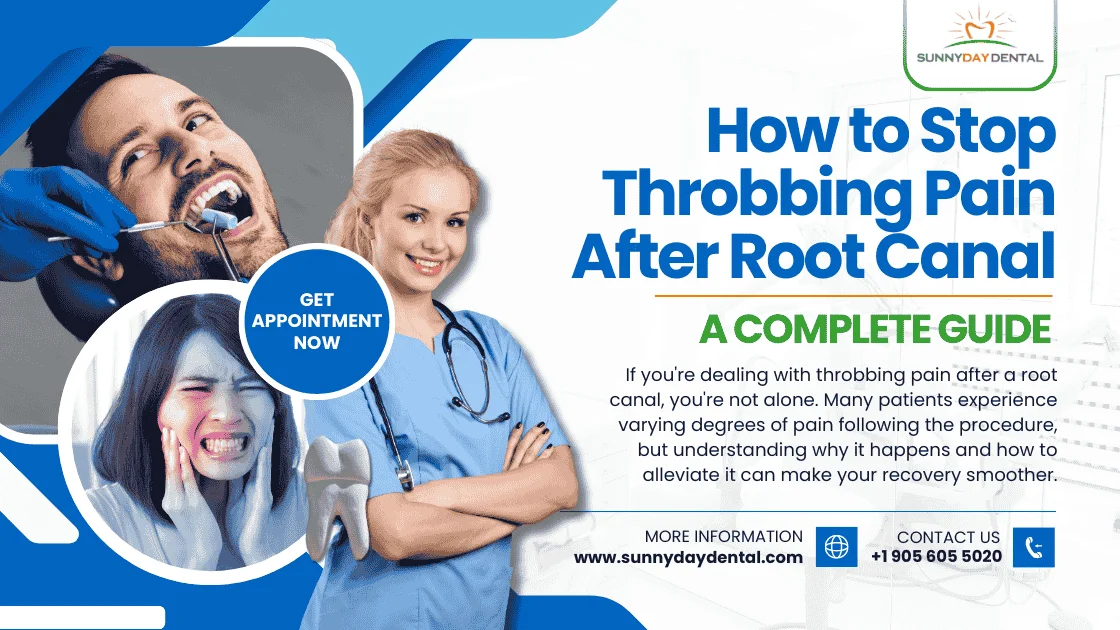Root canals are a common dental procedure aimed at saving infected or damaged teeth, but they often come with temporary discomfort. If you’re dealing with throbbing pain after a root canal, you’re not alone. Many patients experience varying degrees of pain following the procedure, but understanding why it happens and how to alleviate it can make your recovery smoother.
In this guide, we’ll explore effective strategies for managing throbbing pain after root canal, what to expect in terms of recovery, and when to seek further help. Whether you’re experiencing typical post-procedure discomfort or something more intense, this article will provide valuable insights to help you feel better quickly.
Understanding Root Canal Pain: Why It Happens
What is a Root Canal?
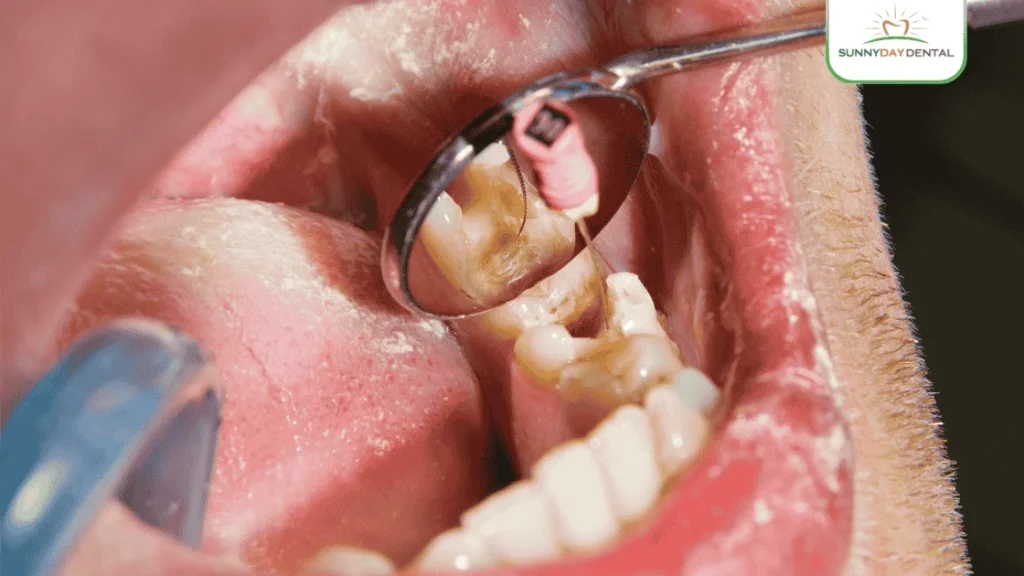
A root canal is a procedure designed to remove infected or inflamed pulp from inside the tooth. This area is then cleaned, disinfected, and sealed. While the infection is addressed, it’s common to experience some pain after the procedure as your body heals.
Why Does Throbbing Pain Occur After a Root Canal?
Throbbing pain after root canal treatment can arise from several factors:
Inflammation: The removal of the infected tissue and the mechanical manipulation of the tooth can cause surrounding tissues to become inflamed.
Healing Process: As your body heals, increased blood flow to the area can create a pulsating or throbbing sensation.
Nerve Sensitivity: Even though the main nerve is removed during a root canal, surrounding tissues can remain sensitive during recovery.
It’s important to differentiate between normal post-procedural pain and pain that indicates complications, such as an infection or damage to surrounding tissues.
Immediate Steps to Relieve Throbbing Pain After Root Canal
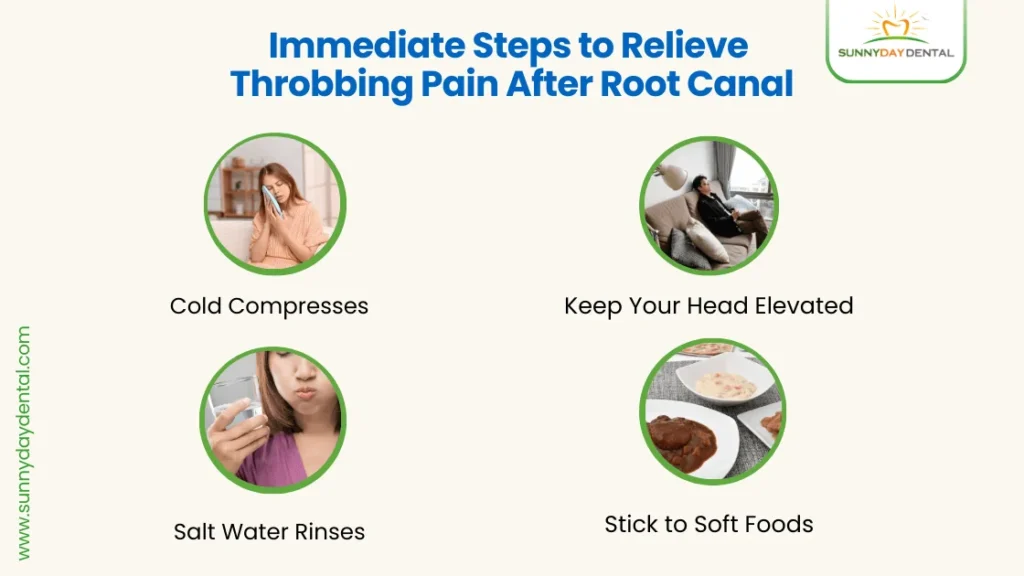
Managing pain after a root canal requires a combination of professional advice and home care strategies. Here are some steps you can take to reduce the discomfort:
1. Cold Compresses
Applying a cold compress to the outside of your cheek can help reduce inflammation and numb the area, which may alleviate throbbing pain. Try this method for 15-20 minutes at a time, several times a day, especially in the first 48 hours post-procedure.
2. Keep Your Head Elevated
Throbbing pain can worsen when lying down, as blood flow increases to the affected area. Keeping your head elevated with an extra pillow can help reduce blood pressure in the tooth and minimize the pulsating sensation.
3. Use Salt Water Rinses
A warm salt water rinse can help keep the area clean and reduce swelling. Mix half a teaspoon of salt into a glass of warm water and gently swish it around your mouth. This not only helps with healing but can also ease discomfort.
4. Stick to Soft Foods
Avoid chewing on the affected side for at least a few days. Opt for soft foods like yogurt, mashed potatoes, and soup, which won’t aggravate the tooth. Hard or crunchy foods can exacerbate pain after a root canal.
When to Seek Help: Recognizing Signs of Complications
While mild to moderate pain after a root canal is common, there are signs that may indicate a problem requiring further attention. Be on the lookout for:
- Severe, Persistent Pain: Throbbing pain after root canal that doesn’t diminish within a few days or becomes worse might indicate an infection or incomplete treatment.
- Swelling or Fever: If you notice swelling, especially around the face, or if you develop a fever, contact your dentist immediately. These symptoms could suggest an abscess or further infection.
- Prolonged Sensitivity to Hot and Cold: While some sensitivity is expected, prolonged or increasing sensitivity to hot or cold temperatures could signal that the root canal wasn’t fully successful, and additional endodontic care may be needed.
If you’re experiencing any of these symptoms, it’s crucial to seek endodontic care in Woodbridge as soon as possible. Your dentist will likely perform a follow-up exam and may recommend additional treatment to resolve the issue.
Long-Term Care: Preventing Future Pain After a Root Canal
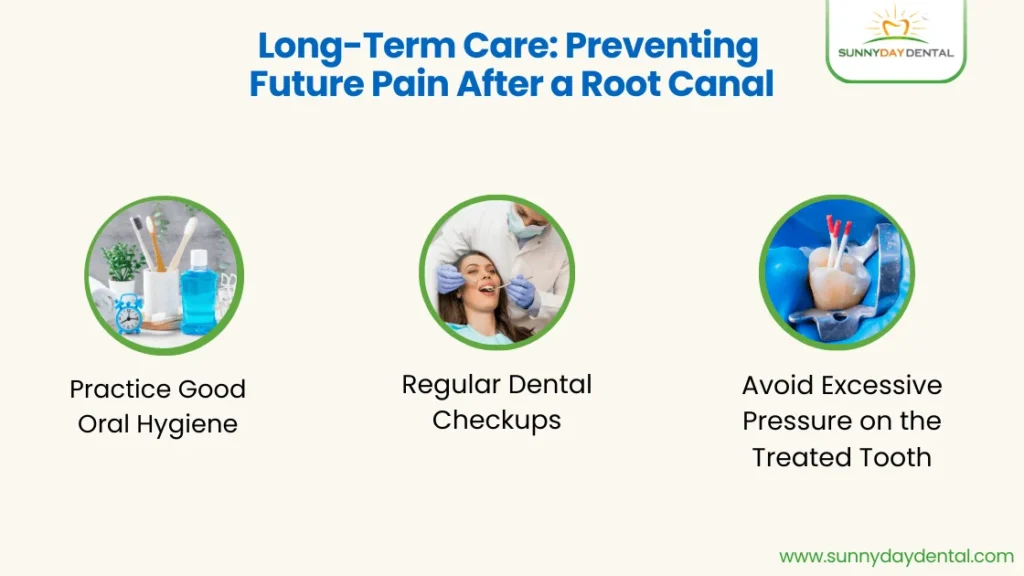
Once the initial recovery phase is over, it’s important to take steps to maintain your oral health and prevent future issues that could lead to pain after a root canal:
1. Practice Good Oral Hygiene
Proper brushing and flossing are essential for keeping your teeth and gums healthy. Be gentle around the treated tooth, but make sure to clean thoroughly.
2. Regular Dental Checkups
Regular visits to your dentist will help monitor the health of your treated tooth and ensure no further issues arise. Your dentist may also recommend a dental crown to strengthen the tooth and prevent fractures.
3. Avoid Excessive Pressure on the Treated Tooth
While your tooth should eventually return to normal function, it’s wise to avoid habits like grinding your teeth or chewing on hard objects (such as ice or pens) to prevent damage to the treated tooth.
Home Remedies to Manage Throbbing Pain After Root Canal?
| Remedy | Benefits |
| Cold Compress | Reduces swelling and numbs the pain |
| Over-the-Counter Pain Relievers | Eases pain and reduces inflammation |
| Salt Water Rinse | Promotes healing and reduces discomfort |
| Soft Food Diet | Prevents irritation of the treated tooth |
| Elevated Head Position | Minimizes blood flow and throbbing pain |
Quick Tips to Stop Throbbing Pain After Root Canal
To relieve throbbing pain after root canal, use over-the-counter pain relievers, apply a cold compress, rinse with salt water, and avoid chewing on the affected side. Elevating your head can also reduce discomfort. If pain persists, seek dental advice promptly.
Eliminate the Fear of Throbbing Pain After Root Canal
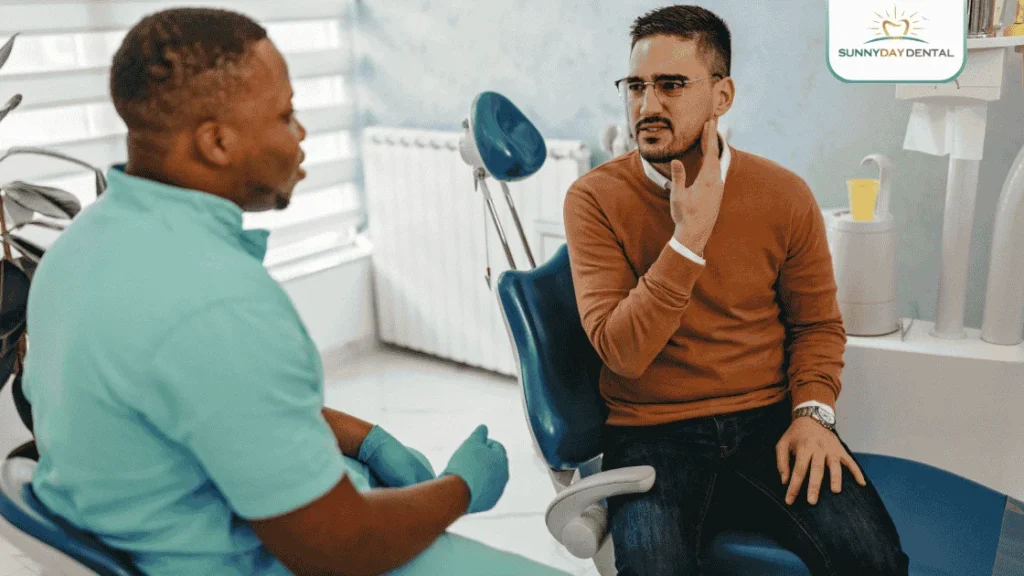
Throbbing pain after a root canal is common but manageable. With proper care and attention, most patients find relief within a few days. By using over-the-counter pain relievers, cold compresses, and being mindful of what you eat, you can significantly ease your discomfort. However, if your pain persists or worsens, don’t hesitate to seek professional advice.
If you’re experiencing root canal pain or need expert endodontic care in Woodbridge, Sunny Day Dental is here to help. Our team of experienced professionals will ensure your post-root canal recovery is smooth and comfortable. Don’t let tooth pain control your life—book an appointment today and get back to feeling your best!
Frequently Asked Questions About Root Canal Pain
1. How long does throbbing pain after a root canal last?
Typically, throbbing pain after a root canal should diminish within a few days to a week. If pain persists longer, it may indicate complications and requires further evaluation by your dentist.
2. Is it normal to have throbbing pain after root canal?
Yes, mild to moderate throbbing pain after a root canal is common and part of the healing process. However, if the pain becomes severe or does not improve, consult your dentist.
3. What can I eat after a root canal?
Stick to soft foods like yogurt, mashed potatoes, and soup for the first few days. Avoid hard, crunchy, or sticky foods that could irritate the treated tooth.
4. Can I work out after a root canal?
It’s best to avoid strenuous physical activity for at least 24-48 hours after your root canal, as increased blood flow can intensify throbbing pain. Focus on rest and recovery.
5. When should I call my dentist after a root canal?
Contact your dentist if you experience severe, worsening pain, swelling, fever, or prolonged sensitivity to temperature. These may be signs of infection or complications.

